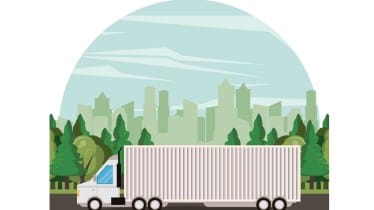By Vivek Gavimath and Spurthi Ravuri
In India, emissions from one truck are equivalent to those from 25 cabs. With the expected increase in economic activity and consumerism, the share of trucks in transportation emissions is bound to increase. Thus, freight decarbonisation is crucial to meet India’s net-zero and energy independence targets.
Transitioning to clean fuel and vehicle technologies is key to decarbonising freight transportation. Among the low-carbon technologies and zero-emission solutions available globally, battery electric trucks (BETs), hydrogen-powered internal combustion engine trucks (H2-ICETs), and fuel-cell electric trucks (FCETs) are strong contenders in India. BETs are proven to be ready for operations in the light-duty truck category and are in the prototype demonstration stage for the medium- and heavy-duty truck categories. FCETs and H2-ICETs remain at the technology demonstration and testing stages, respectively, for all categories.
Our data-driven simulation study comparing unit energy consumption revealed that BETs and FCETs are more energy efficient than ICETs across all tonnages. BETs and FCETs consume 60%–70% and 20%–50% less energy per kilometre, respectively, than ICETs. Early trials show that H2-ICETs consume 40%–50% less energy per kilometre than ICETs (Figure).
Further, while the purchase cost of BETs is nearly thrice that of ICETs, BETs would be about 15% more economical than ICETs to own and operate on long hauls (minimum 500 km/day) by 2030. As the technologies advance and the cost of hydrogen reduces, H2-ICETs and FCETs may become cost-comparable by 2030.
Hence, for the near term, BETs are feasible alternatives over conventional diesel trucks in India, with FCETs and H2-ICETs joining the market by the end of the decade. However, the high upfront cost of BETs and loss in payload-carrying capacity due to battery weight make them commercially unattractive to small fleet owners (constituting about 70% of the trucking industry). These owners operate on wafer-thin margins and typically cannot afford to adopt the technology without support from policies and innovative debt financing instruments.
Policy landscape
The current policies in India have largely supported the adoption of electric passenger vehicles. However, with large industries focusing on reducing their carbon footprint and increasing their carbon handprint, the adoption of green vehicles has received increased attention.
Demand incentives play a vital role in supporting this latent demand for BETs. However, fiscal incentives (i.e. subsidies on purchase prices) that worked for electric passenger vehicles may be unfeasible (comparatively higher amounts per truck) and ineffective (fewer trucks incentivised) for BETs. This necessitates policy innovation in terms of non-fiscal incentives like exemptions for toll, parking, and traffic restrictions. Moreover, innovative debt products attractive to truck owners, such as low rates of interest, buyback options, and affordable product upgrades, can outweigh the high upfront cost.
Technology maturity, domestic manufacturing capability, and economies of scale for BETs can also lower the upfront costs. Industry and academia require adequate support to advance the readiness of BETs through rigorous R&D. As the latent demand converts to real demand, the next step would involve developing BET-specific charging infrastructure along highways. Achieving India’s goal of 50% generation capacity from non-fossil fuel-based sources by 2030 will make the grid and thus these powertrain alternatives greener.
While we celebrate the progress of EV adoption in the nation, especially in the two- and three-wheeler segments, the impact of the revolution on emissions and energy dependency is limited without electrifying trucks. Conservative estimates show that trucks consume four times more fuel than cars, resulting in high associated emissions. Thus, policies need to focus on freight electrification to advance EV adoption nationwide.
The authors work in the area of Green Mobility at the Center for Study of Science, Technology and Policy (CSTEP), a research-based think tank.
Disclaimer: The views and opinions expressed in this article are solely those of the original author. These views and opinions do not represent those of The Indian Express Group or its employees.
